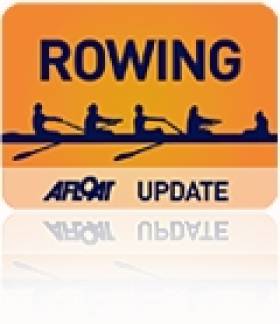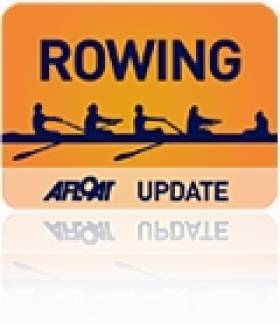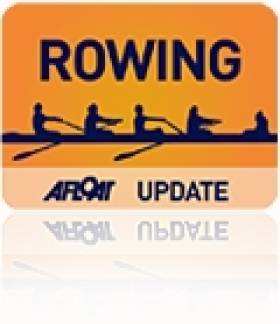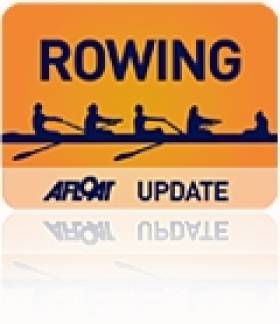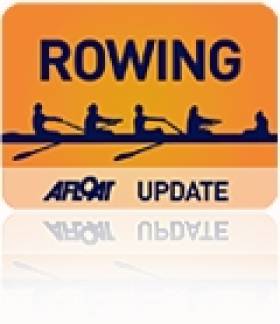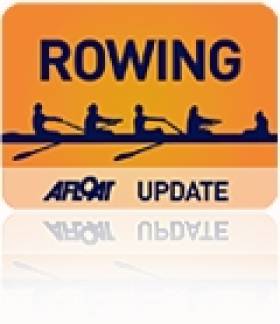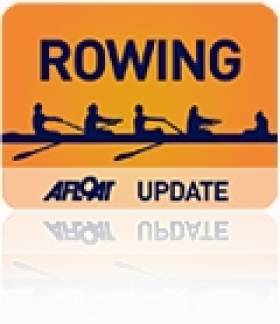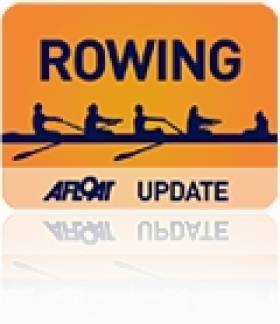Displaying items by tag: rowing
Tough Start to Third Day at Henley for Irish
The first three Irish crews in action at Henley this morning all fell to the superior fire power of seeded crews. The old boys' club of Oxford and Cambridge, 1829 Boat Club, beat Galway Rowing Club in the Thames Cup for club eights; Queen's B could not deal with the slicker ASR Nereus in the Temple Cup for student eights; Star Club beat Commercial after a fine battle in the Wyfold Cup for club fours.
Henley Royal Regatta, Day Three (Irish interest)
Thames Cup (Eights, club): 1829 Boat Club bt Galway RC 3 ¼ l, 6:48
Wyfold Cup (Fours, club): Star Club bt Commercial 2l, 7:14
Temple Cup (Eights, student): Amsterdamsche Studenten Roeivereeniging Nereus, Netherlands bt Queen’s B 2½ l, 6:42
Click this link for Irish Rowing detailsClick this link for the Latest Rowing News
Galway-Muckross Exit Visitors' Cup
An Argentinian composite crew which had terrible steering problems early on passed and beat the Galway Rowing Club/Muckross crew in the first round of the Visitors' Cup at Henley Royal Regatta. The crew from Club San Fernando and Club de Regatas la Plata trailed at the Barrier, but stuck to their task and beat the Irish by two lengths.
Carlow got the Irish back on track with a good one-length win over Star Club in the Thames Cup. Lightweight oarsman Peter Chambers mixed it with a man four stone heavier in the Diamond Sculls and lost by only a length and a half in the Diamond Sculls to British heavyweight oarsman Brendan Crean.
The day ended superbly for UCD, who were led by Goldie in the Prince Albert for student coxed fours but went on to win by three-quarters of a length.
Henley Royal Regatta (Irish Interest)
Diamond Sculls (Single Scull, Open): B Crean (Agecroft RC) bt P Chambers (Oxford Brookes University) 1 ½ l, 8:37
Visitors’ Cup (Fours; Intermediate): Club San Fernando and Club de Regatas la Plata, Argentina bt Galway RC and Muckross 2l, 7:36
Thames Cup (Eights, club): Carlow bt Star Club 1l, 7:15
Prince Albert (Fours, coxed; Student): UCD bt Goldie BC ¾ l, 7:19
Click this link for Irish Rowing details
Click this link for the Latest Rowing News
Double Joy for Queen's on Day Two at Henley
Queen's A and B crews qualified for the quarter-finals of the Temple Cup for student eights at Henley Royal Regatta, topping off a list of five out of six wins for Irish crews before lunch on the second day of the event. The Queen's A crew were never seriously troubled by University of London, while the B crew did well to beat Nottingham, who had seen off a seeded crew, Newcastle University, in the first round.
Two Irish crews justified their seeding in the Wyfold Cup for club fours. Commercial beat Vesta, and Muckross overcame Molesey, who mounted a strong challenge. Molesey inflicted the one early defeat on the Irish, when their heavier crew took advantage of the headwind to beat St Michael's in the Thames Cup for club eights. Galway did better in this event, beating Thames Tradesmen.
Henley Royal Regatta, Day Two (Irish interest)
Thames Cup (Eights, club): Galway RC bt Thames Tradesmen RC 3½ l, 7:11; Molesey BC A bt St Michael’s 2¼ l, 7:03
Wyfold (Four, club): Commercial bt Vesta RC 1l, 7:33; Muckross RC bt Molesey BC ¾ l, 7:35
Temple (Eights, Student): Queen’s University A bt University of London A 2 ¼ l, 7:04; Queen’s University B bt Nottingham University 3¼ l, 7:05
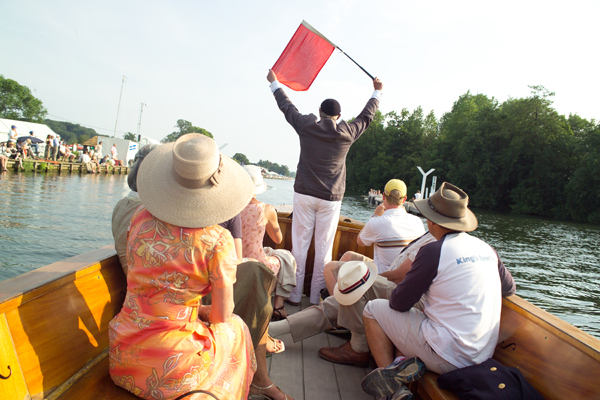
The Umpires launch. Photo: oepkes.com
Click this link for Irish Rowing detailsClick this link for the Latest Rowing News
Remarkable Morning for Irish at Henley
Irish crews were involved in six races this morning at Henley Royal Regatta and won all six. Both Queen's A and B crews had convincing victories in the Temple Cup for student eights, while Carlow and Galway won their heats of the Thames Cup for club eights by three lengths and one and three-quarter lengths respectively. UCD took on and beat Oxford Brookes B in the Prince Albert for student coxed fours and Cork were also convincing winners against Grosvenor in the Britannia for coxed club fours.
In one of the last races before lunch, Muckross, who were seeded in the Wyfold, beat Putney Town by a big margin.
The pattern continued in the afternoon, with St Michael's and Commercial commanding winners in the Thames Cup and Wyfold Cup. Galway Rowing Club fought hard in the final Irish race of the day in the Wyfold Cup, but fell to Nottingham and Union.
Henley Royal Regatta, Day One (Irish interest)
Thames Cup (Eights, club): Galway RC bt Maidstone Invicta RC 1¾ l, 6 min 46 secs; Carlow RC bt Vesta RC 3l, 7:07;
St Michael’s bt Combined Services RC easily, 7:12
Britannia (Fours, coxed; club): Cork BC bt Grosvenor RC 2½ l, 7:33
Wyfold Cup (Fours; club): Muckross RC bt Putney Town RC 4½ l, 7:30; Commercial bt Quintin BC 2l, 7:33; Nottingham and Union BC bt Galway RC 1 ¾ l, 7:19
Temple Cup (Eights; student): Queen’s University, Belfast A bt University of Bristol 4¾ l, 6:38; Queen’s University B bt University of Cape Town 3l, 6:45
Prince Albert (Fours, coxed; student): University College, Dublin bt Oxford Brookes University B 2¾ l, 7:20
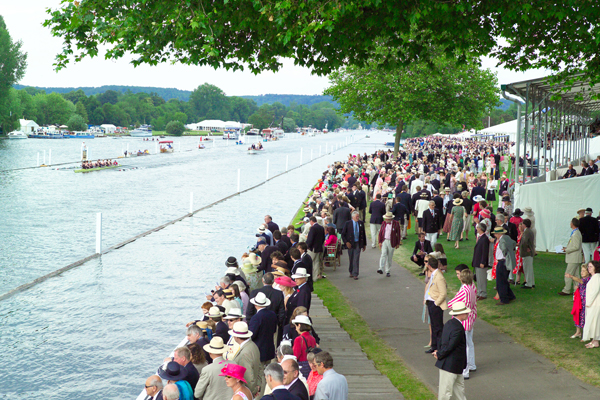
The Henley enclosure. Photo: oepkes.com
Click this link for Irish Rowing details
Click this link for the Latest Rowing News
Bann Best in Athlone Battle
Bann won the shoot-out among the top junior 18 eights at Athlone Regatta. The Derry club finished ahead St Joseph's of Galway, Portora and Presentation in the final race of the day. Neptune intermediates, who raced alongside the junior crews, also had to give way to Bann, finishing half a length down. Commercial's women senior eight were the best of the day, but had only half a length to spare over Portora, with a composite crew a close-up third.
Athlone Regatta, Coosan Point
Men, Eight – Novice: 1 UCD A, 2 UCD B, 3 Trinity. Junior 18/Intermediate: 1 Bann junior 18, 2 Neptune intermediate, 3 St Joseph’s junior, 4 Portora junior, 5 Presentation junior; ½ l, 1l, 2ft, 2l. Junior 16: 1 St Joseph’s, 2 Methodist College, Belfast. Masters: 1 Commercial, 2 City of Derry.
Four, coxed – Intermediate: 1 Neptune, 2 Clonmel. Novice: 1 Shannon, 2 Fossa, 3 Trinity. Junior: 1 Bann, 2 Portora.
Pair – Senior: 1 Cappoquin, 2 Neptune, 3l. Intermediate: 1 Cappoquin, 2 Clonmel. Junior 18: 1 Lee, 2 Neptune.
Sculling, Quadruple – Novice: 1 Carrick-on-Shannon, 2 Offaly. Junior 16: 1 Commercial, 2 Lee.
Double – Intermediate: 1 Castleconnell, 2 Lee. Junior 18: 1 Neptune, 2 Offaly. Junior 16: 1 Lee, 2 Neptune.
Single – Senior: 1 Neptune (King), 2 Garda (Duane), 1 ft. Intermediate: 1 Neptune (Bailey), 2 Clonmel (Pidgeon). Novice 1 Offaly (O’Connor), 2 Neptune (Janssens). Junior 18: 1 Athlone (Egan), 2 Cork (O’Brien) 2 ft. Junior 16: 1 Lee (Synott), 2 Lee (Collins).
Women
Eight – Senior: 1 Commercial, 2 Portora, 3 Commercial, Cork, Killorglin, Portora (composite); ½ l, ¼ l. Novice: 1 UCD, 2 Trinity, 3 Neptune. Junior 18: 1 Portora, 2 St Michael’s.
Four – Senior: 1 Commercial, 2 Cork. Novice, coxed: 1 Trinity, 2 UCD. Junior 18: 1 Commercial, 2 Cork.
Sculling
Quadruple – Novice, coxed: 1 Neptune, 2 Clonmel. Junior 18: 1 Bann, 2 Neptune. Junior 16: 1 Bann, 2 Carlow.
Double – Intermediate: 1 Killorglin, 2 City of Derry. Junior 18: 1 Bann, 2 Waterford.
Single – Senior: 1 Killorglin (M Dukarska), 2 Cork (M O’Neill). Novice: 1 Shandon (Corcoran-O’Hare), Bantry (Piggott). Junior 18: 1 Waterford (McGrath), 2 Bann (Shirlow). Junior 16: 1 Killorglin (Crowley), 2 Lee (Hamill).
Click this link for Irish Rowing detailsClick this link for the Latest Rowing News
Irish Women's Quadruple Qualifies for Henley
An Irish women's quadruple scull has made it through the qualifiers for Henley Royal Regatta. Rachel Beringer, Amy Duncan, Laura D’Urso and Dympna Kelly will compete in the Princess Grace Challenge Cup at the regatta proper. Imperial College London and Sport Imperial Boat Club were the only other qualifier in this event.
Click this link for Irish Rowing detailsClick this link for the Latest Rowing News
Skibbereen Widen Gap at top of Grand League
Skibbereen Rowing Club have maintained their dominance at the top of the Rowing Ireland Grand League following the Metro regatta, the fourth in the six series league. They have now increased their lead over nearest rivals, Dublin club, Neptune by 128 points.
The leading clubs after the fourth regatta are: Skibbereen 573, Neptune 445, St. Michael’s 373, Commercial 358, UCD 262
Skibbereen’s lead is now significant and it will be difficult for Neptune to topple them at this stage. However St..Michael’s, Commercial and UCD will still be fighting it out for the coveted third spot.
St Michaels, Limerick lead the men's senior category on 195 points, with Neptune overtaking Commercial on 142 and UCD remaining in third on 121 points. UCD maintain their lead 141 points in the women’s senior category despite their absence at Metro with Dublin University overtaking NUIG for a second placing with the Galway club third on 101.75 points.
Skibbereen RC remain top of the junior men category on 216 with Neptune overtaking St. Joseph’s, Galway (The Bish) in second on 120 with Lee Rowing Club in third on 101.
Skibbereen and St. Michael’s topping the junior women on 125 and 80 points respectively.
The Grand League takes a break now until August to make way for the Irish Rowing Championships which take place on Saturday 16th July. The league will resume with the Limerick and Monkstown regattas in August.
|
1 |
SKIBBEREEN ROWING CLUB |
573 |
|
2 |
NEPTUNE ROWING CLUB |
445 |
|
3 |
ST MICHAEL'S ROWING CLUB |
373 |
|
4 |
COMMERCIAL ROWING CLUB |
358 |
|
5 |
UNIVERSITY COLLEGE DUBLIN BOAT CLUB |
262 |
|
6 |
LEE ROWING CLUB |
232 |
|
7 |
CORK BOAT CLUB |
193 |
|
8 |
NATIONAL UNIVERSITY OF IRELAND, GALWAY, BOAT CLUB |
189.75 |
|
9 |
CARRICK-ON-SHANNON |
165 |
|
10 |
SHANDON BOAT CLUB |
152 |
For full tables go to results at http://iaru.ie/main.php
Click this link for Irish Rowing detailsClick this link for the Latest Rowing News
Charity Rowers Row for Africa
Transatlantic rower Sean McGowan will join two of Inishowen's best known charity workers - whose ages total 153 years - in a sponsored 25-mile row this weekend in aid of Self Help Africa.
Albert Doherty (68) and Willie Harrigan (85) will be joined by rowers from clubs in Glenarm in Co. Antrim and Arklow. Also taking part will be Sean McGowan who last year rowed solo across the Atlantic in 188 days.
The row from Prehen Boat Club in Derry to Moville will take place on Saturday 26th June with the "winner" the person with the most money raised on their sponsorship card, receiving a trophy in memory of the late Betty Nicell from Derry.
This will be the fifth time Albert and Willie will row the Foyle in aid of Self Help Africa and this year will see them undertake the trip in a boat personally restored by Albert.
To date Albert's fundraising has totalled approximately €28,000 - an achievement recognised last year by President Mary McAleese.
Anyone wishing to take part or make donations can do so by contacting Albert on 074 93 83360.
Click this link for the Latest Rowing News
Youngest cox features at Henley Women's Regatta
10-year-old Rory Keogh is a cox at the Henley Women's Regatta The youngest ever competitor will be taking part at Henley Women's Regatta.
Rory Keogh, 10, from Dublin will steer a boat worth £13,000, leading four athletes down a 1500 metre course in the event. He is coxing the senior four of Áine Feeney, Jane Shackleton, Laura Byrne and Naomi Fearon.
In his native Ireland Rory is under the minimum weight to take part in races but the rules differ in the UK. The regatta chairman Diane Graham explains how he is able to compete: "At just under 30 kg, we're having to bring extra dead weights to the events as he'll have to take around two thirds again of his weight into the boat to make it up to the minimum!"
"I'm happy to be there and I'm very excited about it," Rory told BBC Oxford. When asked to explain his job he said: "You have to steer straight as long as possible. "You only steer if you absolutely have to because if they put on the tiller then it's harder. It's like a running race when you're coming round the corner. "And you have to encourage them loads."
Rory got involved in rowing in September 2009 and hopes to row in the Olympics when he is older. He says his current success is getting him a lot of attention at school. "They're all asking me questions like 'Are you getting paid for Henley?'" His father Dermot is the current captain of Commercial Rowing Club, Dublin.
"It's very unusual for them to start so early but he took to it like a duck to water," he told BBC Oxford.
"When he says something in a boat he gets a response. He turns heads all the time because he just has a command when he says something.
"I think he'll have to go into politics!"
The regatta will host over 1500 competitors and 40 overseas crews from the US, Australia and Europe.
Click this link for the Latest Rowing News
Olympians Power Muckross to win over NUIG at Metro Regatta
Olympians Paul Griffin and Seán Casey helped power Muckross to a fine win over NUIG in the Men’s Senior Eight race at the Metro regatta in Blessingtion over the weekend. The result was a reversal of last month’s Cork regatta where NUIG beat Muckross.
NUIG did win the Men’s Fours beating Commercial by a fraction of a second with Galway taking third place.
The Men’s pairs race was an all-St. Michael’s contest which threw up the big surprise of the day. In a contest between older and young brothers, the younger St. Michael’s B crew of Declan O’Connor and Hughie Lynch beating their older brothers, the St. Michael’s A crew of Kevin O’Connor and former World Champion and Olympian Sam Lynch. Commercial took the third spot.
Skibbereen took the Men’s quads and double sculls convincingly and while Skibbereen made up four of the rowers in the single scull, it was John Keohane who took the honours for Lee Valley Rowing Club.
In the Men’s Division Two, UCD won the Eights, Fossa, Killarney won the Fours and Carrick-on-Shannon won the single sculls.
In the Women’s Division One single sculls, Dympna Kelly, Carrick on Shannon beat Sheila Clavin of St. Michael’s, Limerick. Both rowers have crewed at international level in the double sculls. Neptune have been dominant all season in the pairs and took the honours again at Metro. Skibbereen won the quad and Commercial won the fours.
The men’s and women’s singles and pairs races were a selection trial for the upcoming Home Internationals, the annual competition between Ireland, Scotland, England and Wales.
Grand League Metro Regatta, Blessington - Results
Men’s Senior
8+ Muckross
4+ NUIG
2- St. Michael’s B
4x Skibbereen
2x Skibbereen
1x John Keohane, Lee Valley RC
4x Skibbereen
4 - Commercial
2 - Neptune
1x Dympna Kelly, Carrick on Shannon
Click this link for Irish Rowing detailsClick this link for the Latest Rowing News


























